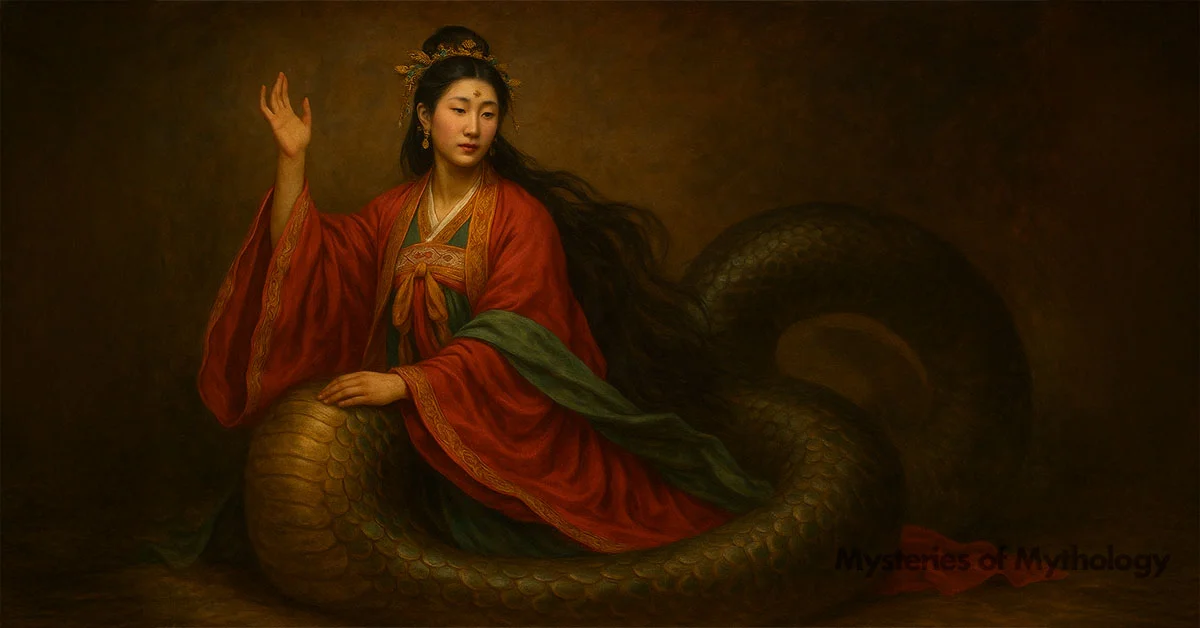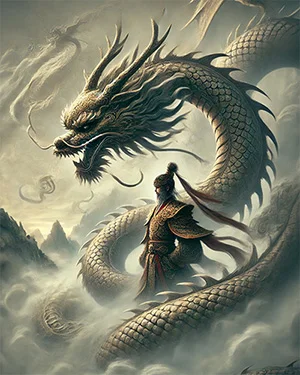Overview
Nüwa (女娲) is one of the most significant figures in Chinese mythology, revered as both a creator and a saviour. She is best known for two monumental acts: creating the first human beings and repairing the sky after a catastrophic collapse. Her stories, which appear in texts as early as the Shan Hai Jing and Huainanzi, offer insight into ancient Chinese understandings of the cosmos, divine responsibility, and social hierarchy.
Portrayed with the upper body of a human and the lower body of a serpent or dragon, Nüwa is often depicted alongside her brother and consort, Fuxi. Together, they are seen as the progenitors of civilisation. Unlike many gods associated with war or rulership, Nüwa’s role is maternal, constructive, and deeply compassionate. She intervenes when divine conflicts threaten to wipe out humanity and uses her own powers to mend a broken world.
This article explores the mythology of Nüwa in detail, including her name’s meaning, physical appearance, mythological deeds, family ties, and her legacy in modern culture.
Want to know more? Read on…
Watch the related video
Etymology
The name “Nüwa” (女娲) is composed of two Chinese characters. “女” (nǚ) means “woman” or “female,” while “娲” (wā) has no clear modern meaning but is thought to be an ancient phonogram. The character 娲 is uncommon in everyday Chinese and primarily appears in mythological or religious contexts.
Some scholars interpret 娲 as having connotations related to fertility or the feminine principle in early Chinese cosmology. There are also phonetic links in ancient dialects to words for coiling or twisting, which may be relevant given Nüwa’s serpent-like depiction.
Pronunciation
Pronunciation
ENGLISH
Nuwa
Mandarin
女娲
PHONETIC
[nyoo-wah]
IPA
/nyː˧˩.wa˥/
Alternate Names
Nüwa is also known by various names, including Nügua, Nu Wa, and Wa Huang (Empress Wa), reflecting regional dialects and historical texts.
Attributes
Appearance
Nüwa is typically depicted with a human upper body and a serpent or dragon lower body, often coiled or intertwined with Fuxi. This form symbolises her connection to ancient cosmic forces and early animal symbolism. In Chinese art, she is often shown holding a compass while Fuxi holds a square, representing yin and yang, or heaven and earth.
Origination
According to myth, Nüwa emerged after the death of the primordial being Pangu. In some versions, she is the daughter of Huaxu, who became pregnant after stepping into a divine footprint, leading to the birth of Nüwa and her brother Fuxi.
Abilities
Nüwa’s powers are focused on creation, restoration, and balance. She is credited with:
- Creating human beings from yellow clay
- Repairing a rupture in the sky using melted stones
- Replacing a fallen cosmic pillar with the legs of a giant turtle
- Calming floods and killing a dragon that threatened humanity
These actions reflect control over both earth and celestial forces.
Habitat
Nüwa does not have a fixed celestial domain like some other gods in Chinese lore. Her presence is often associated with mythic landscapes such as Mount Buzhou, the five-coloured stones, and the Yellow River basin, reflecting her interventionist role in the natural world rather than ruling from a distant heaven.
Family
Nüwa is usually described as the sister and consort of Fuxi, another central culture hero who brought tools, writing, and social order to early humanity. In some myths, they are the last surviving beings after a great flood and are responsible for repopulating the earth. The sibling-marriage motif is found in many creation myths around the world and was often symbolic rather than literal.
Family Tree
Parents
Mother
Huaxu
Spouse/Brother
Husband
Fuxi
Mythology
The People of Clay
In the earliest days of the world, after Pangu had separated the heavens from the earth, Nüwa wandered the newly formed land. The mountains stood tall, rivers flowed freely, and animals roamed the earth, but there were no beings like her. Feeling a profound loneliness, she decided to create companions. Gathering yellow clay from the riverbanks, she moulded figures in her own image. As she placed them on the ground, they came to life, dancing and speaking, bringing joy to Nüwa. These were the first humans.
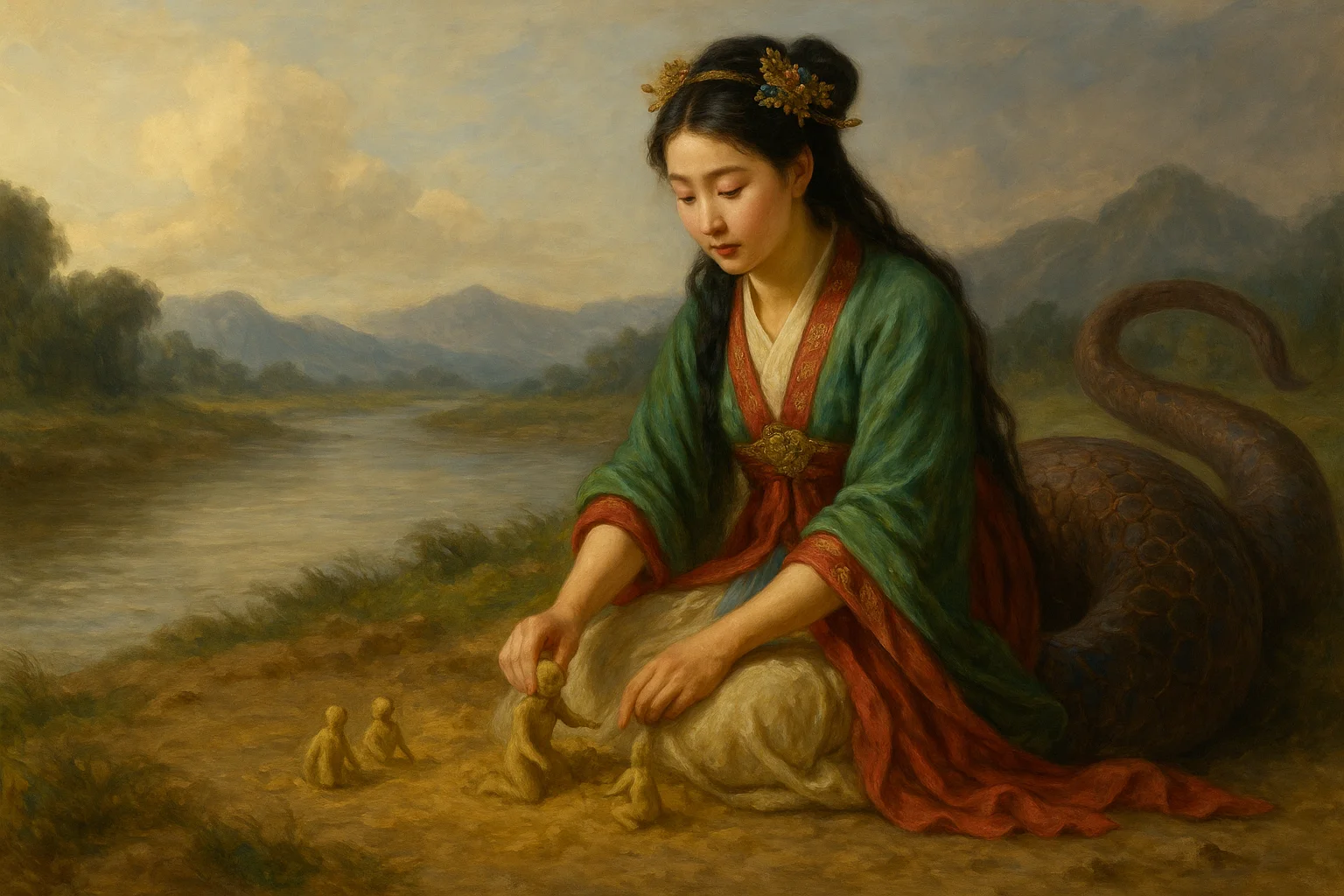
However, crafting each human individually was time-consuming. To expedite the process, Nüwa dipped a rope into the muddy water and swung it around, creating droplets that formed more humans upon touching the earth. It’s said that those she crafted by hand became the nobility, while those formed from the mud droplets became the common people, reflecting early notions of social hierarchy.
The Marriage
In another tale, a catastrophic flood wiped out humanity, leaving only Nüwa and her brother, Fuxi, as survivors. Recognising the need to repopulate the earth but hesitant due to their sibling relationship, they sought a sign from the heavens. They climbed separate mountains and lit fires, agreeing that if the smoke from their fires intertwined, it would signify divine approval for their union. The smoke merged in the sky, and taking this as a sign, Nüwa and Fuxi married and together repopulated the world.
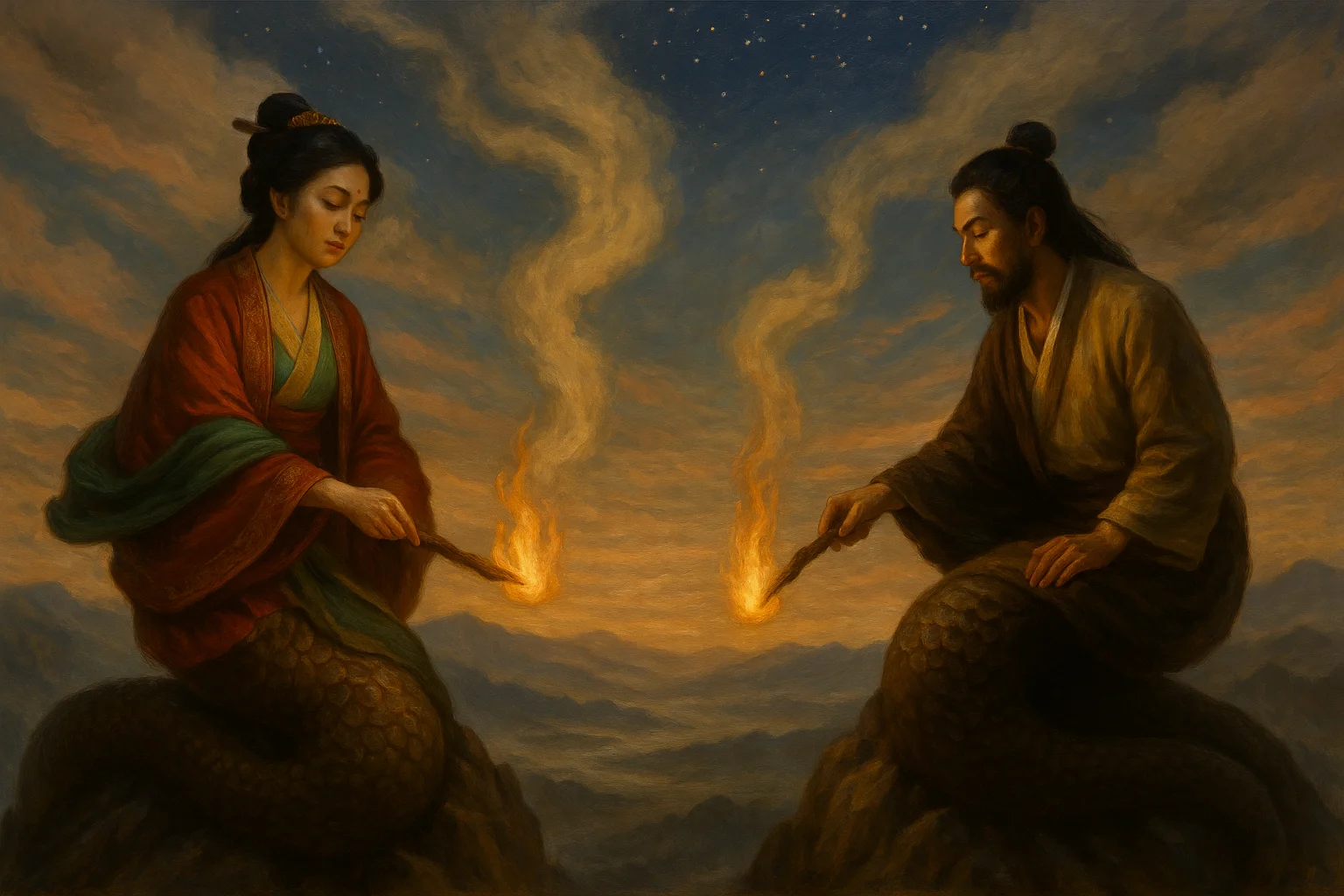
Mending the Pillars of Heaven
The world once stood balanced, with the sky held up by four great pillars. A fierce battle between the water god Gonggong and the fire god Zhurong led to Gonggong smashing his head against Mount Buzhou in defeat, causing one of the pillars to collapse. The sky cracked, fires raged, floods ensued, and chaos reigned.
Moved by the suffering of her creations, Nüwa took it upon herself to restore balance. She gathered five colored stones—red, yellow, blue, white, and black—and melted them to patch the hole in the sky. To replace the fallen pillar, she cut off the legs of a giant turtle named Ao and used them to support the heavens. Though her repairs restored order, the sky remained slightly tilted, explaining why rivers in China flow southeast and the sun and stars move westward.
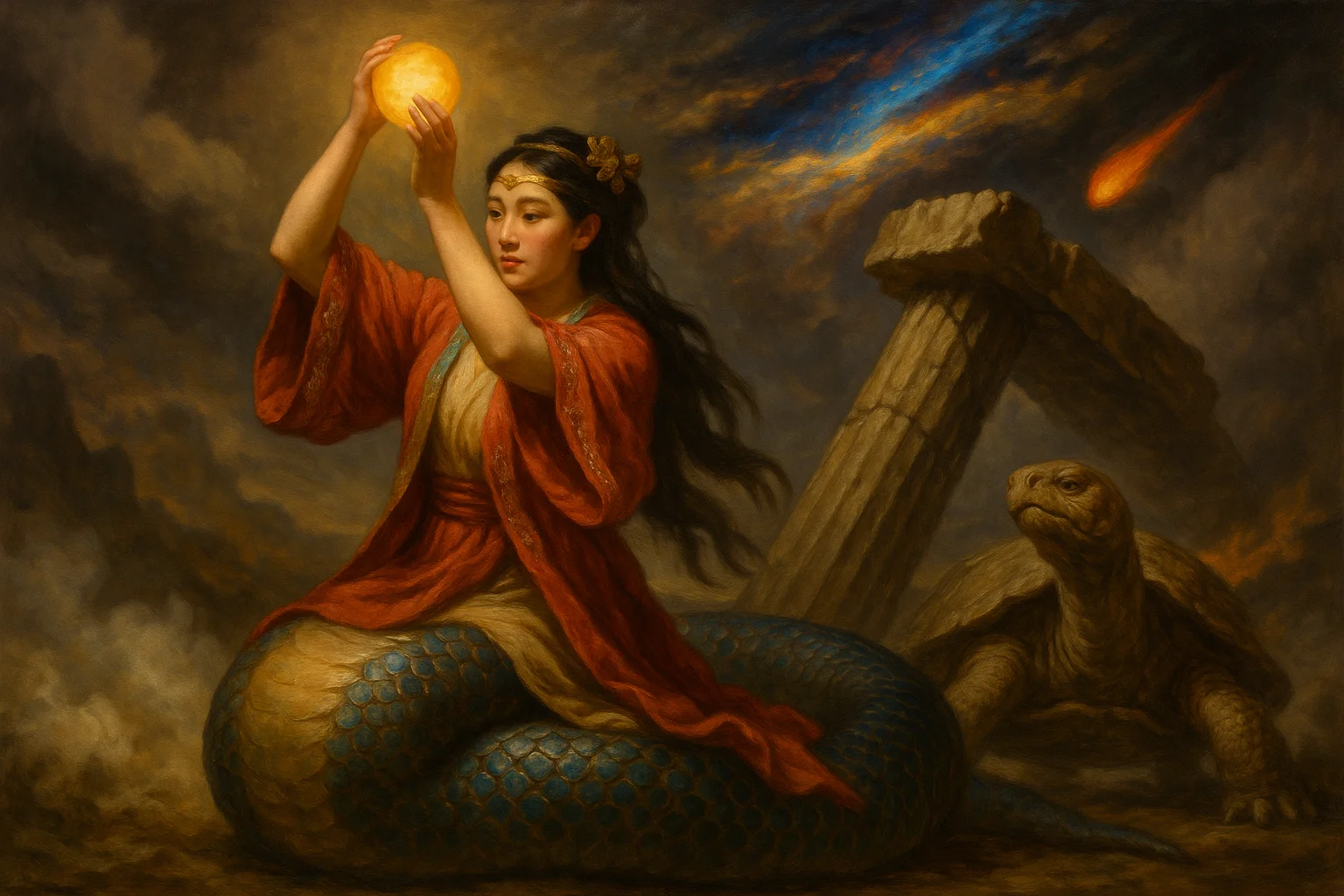
Worship
Nüwa’s reverence persists in various regions. Temples dedicated to her, such as the Nüwa Palace in Hebei Province, serve as ancestral shrines. Celebrations on her birthday, believed to be March 15, involve singing, dancing, and offerings like embroidered shoes, seeking blessings for health and happiness.
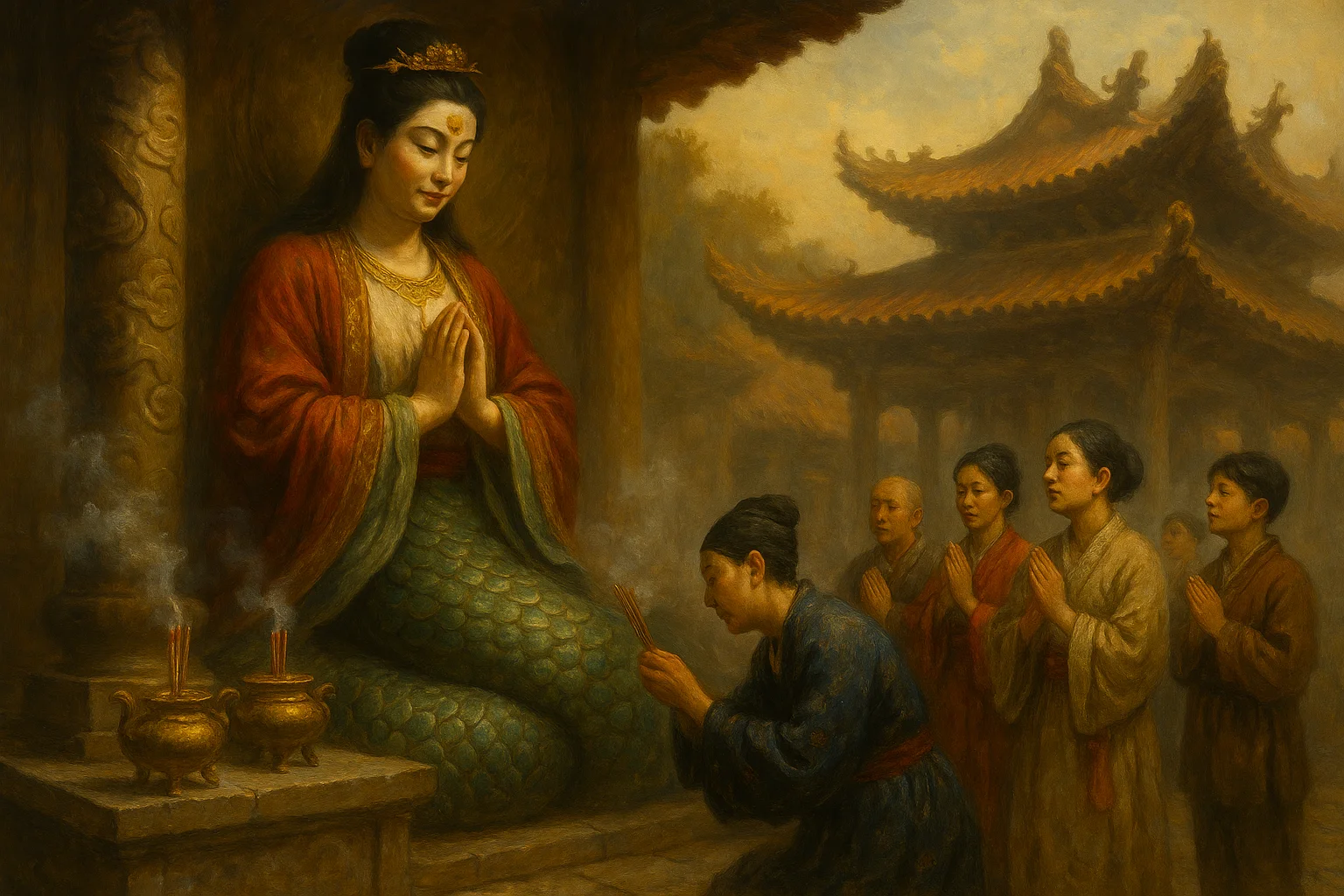
Pop Culture
Nüwa’s legacy extends into modern media:
Literature & Art: Inspires various works exploring themes of creation, femininity, and resilience.
Video Games: Featured in titles like Smite, Arcane Legions, and Warriors Orochi 2, often depicted wielding a sword and shield.
Frequently Asked Questions
Who is Nüwa in Chinese mythology?
Nüwa is a goddess credited with creating humanity and repairing the sky after a cosmic disaster, embodying themes of creation and restoration.
What is Nüwa known for?
She is renowned for molding humans from clay and mending the heavens using five colored stones and a giant turtle’s legs.
Is Nüwa still worshipped today?
Yes, particularly in regions with temples dedicated to her, where rituals and festivals celebrate her contributions.
What does Nüwa symbolise?
Nüwa symbolises creation, compassion, and the balance between chaos and order.
How is Nüwa depicted in art?
She is often portrayed with a human upper body and a serpent or dragon-like lower body, reflecting her dual nature.
References
- The Editors of Encyclopædia Britannica. “Nu Gua.” Encyclopædia Britannica. https://www.britannica.com/topic/Nu-Gua.
- New World Encyclopedia contributors. “Nuwa.” New World Encyclopedia. http://www.newworldencyclopedia.org/entry/Nuwa.
- Werner, E.T.C. Myths and Legends of China. World Book: A Scott Fetzer Company, 2015.
- Wikipedia contributors. “Nüwa.” Wikipedia. https://en.wikipedia.org/wiki/N%C3%BCwa.
- Yang, Lihui, Deming An, and Jessica Anderson. Handbook of Chinese Mythology. New York: Oxford University Press, 2008.
- Ying, Zhu. “Nuwa mends a hole in the sky.” Shanghai Daily. https://archive.shine.cn/feature/art-and-culture/Nuwa-mends-a-hole-in-the-sky/shdaily.shtml.

